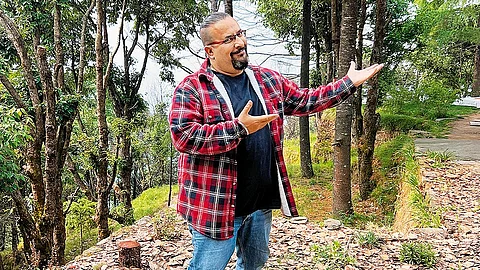
- Destinations
- Experiences
- Stay
- What's new
- Celebrating People
- Responsible Tourism
- CampaignsCampaigns
- Subscribe
- Buy Now

Pangot is 14 km from Nainital, and I was there for the first time almost 30 years ago. What a place it was then. Lush green forest, a profusion of Himalayan birds and some great food at an old friend’s place, which was nearing completion. The agenda was to go birding, which has long been my passion, so the day started pre-dawn for me.
After enjoying a hot cup of coffee while it was still dark outside, I set off with my camera and my over-enthusiastic labrador retriever. The morning was perfect, and as the first light broke, I found myself sitting on a steep slope, watching a few kalij pheasants feed peacefully. I managed to capture some decent shots. Six hours later, I fully understood why Pangot is considered a birdwatcher's paradise. Despite the cold winter wind that seemed to cut straight through to my bones, I thoroughly enjoyed my morning walk. It wasn’t long before I was hurrying back to find shelter and, of course, a well-deserved meal.
After a long walk in the windy woods, entering the small round room that served as both the kitchen and dining area, warmed by a crackling fire, felt like a little piece of heaven. The mutton curry and paneer makhani were absolutely divine, though both needed nearly twice the amount of salt I typically use.
If you’ve ever enjoyed a hot meal on a cold winter’s day in the mountains, you’ll know exactly what I mean. I can still recall every nuance of the taste. Food always seems to taste better up there, doesn’t it? Your sense of taste feels heightened, but it’s actually the opposite. Let me explain.
Our taste buds function best at sea level, where the body experiences 1,01,325 Pascals of pressure—commonly referred to as 1 atmosphere (atm). This is the weight of the atmosphere above you, stretching to space and pressing down on your body. As altitude increases, atmospheric pressure decreases, dulling your ability to perceive saltiness and sweetness.
At sea level, in regions like Gujarat, Bengal, or Kerala, the food is often a vibrant blend of sweetness and saltiness, offering unparalleled delight to our taste buds. Our bodies naturally adapt to these conditions, with optimal oxygen levels enhancing sensory experiences.
Taste is largely influenced by smell—some estimates suggest over 80 per cent—with the rest determined by taste buds. Together, they create the perfect symphony of flavours, best enjoyed at sea level.
Our taste buds function best at sea level. As altitude increases, atmospheric pressure decreases and dulls our sense of saltiness and sweetness
The reason why some people find food tastier in the high mountains is because your fifth taste, umami, becomes more pronounced at higher altitudes. Your perception of sweetness and saltiness may diminish but these flavours are easy to adjust in your meals. For someone like me, whose passion and profession are centred around taste, exploring these nuances is incredibly exciting. Think back to the best momo you’ve ever had—chances are, it was in the hills. Up there, it's all about fully embracing the essence of umami.
Thirty four years ago on the inaugural flight of an international airline, I witnessed something that completely changed my understanding and appreciation of flavour. The long sink was lined with large wooden slats, and one by one, bottles of expensive white wine were opened and poured down the drain.
Hundreds of cases had been purchased to serve in business class, selected for their crisp taste and dry, acidic notes. However, when the wine was served to passengers, they complained it was far too acidic and dry.
The problem became clear only at 34,000 feet. The reduced pressure and lower oxygen levels at cruising altitude had intensified the acidity, making the wine nearly undrinkable. With no way to sell or even give away the stock, the airline had no choice but to dispose of it all—a costly lesson in how altitude can dramatically alter taste.
Even though the oxygen levels are similar to those in Delhi, people tend to feel lighter and more refreshed in places like Shimla and Nainital. At around 6,500 feet, food tastes better with the cleaner air and slightly improved oxygen absorption, along with heightened umami sensations.
Ingredients are better preserved in shops in the hills compared to warmer cities due to the lower temperatures. Transporting vegetables, for example, takes less of a toll on them.
But, honestly, why get so technical?
When you’re on holiday, you tend to care less about what you’re eating and indulge a bit more than you would otherwise.
You enjoy food with a greater sense of freedom and less stress. You have more time to savour it, pay more attention to each bite, choose better condiments, and relish the pickles, chutneys, salads, and fruits. This results in a much better dining experience almost every time.
This is just a gentle reminder: take some time for yourself, eat well, laugh a little more, spend more time with family and friends, and relax. It’s not just the food that will taste better, but life as a whole will feel a little tastier. Bon appétit!
Rocky Singh is a food enthusiast, television personality, and travel show host who has travelled across India and beyond. You can follow him on Instagram/@rockyeatsig
Get Your Copy Now!
Don't miss out on the latest issue of Outlook Traveller! Click here to grab your copy.
